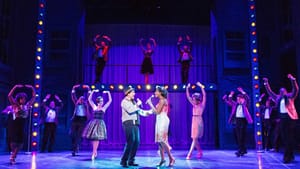Stay in the Loop
BSR publishes on a weekly schedule, with an email newsletter every Wednesday and Thursday morning. There’s no paywall, and subscribing is always free.
'Memphis' at the Walnut Street Theatre (second review)

Memphis, winner of four Tony awards and four Drama Desk awards, is the last show of Walnut Street Theatre’s season. They’re going out with an electrifying, mind-blowing, heart-grabbing, foot-stomping, do-wop, head-bopping bang.
Set in the early 1950s, Memphis is about a white DJ, Huey (Christopher Sutton), who loves rhythm and blues and gospel music. He finds himself also drawn romantically to Felicia (Kimber Sprawl), a black singer looking for her big break.
Needless to say, this romantic attraction did not sit well with Felicia’s brother Delray (Philip Michael Baskerville), or with Huey’s Mama (Mary Martello). It was a time when relationships between whites and blacks, especially in the south, were taboo.
Oh What a Night
The opening scene takes place at Delray’s club, down on Beale Street on the black side of Memphis, where there is a lot of dancing and singing going on. (Actually, if I revert to Ebonics, there was a lot of hoofin’ and sangin’ goin’ on.)
Huey is drawn to the soulful sounds coming from inside the club, and everything comes to a halt when he slowly steps in. However, when challenged by Felicia, we see that Huey is anything but fearful of where he is — he’s been ignited by the black culture that he says is “part of his soul.”
Creators Joe DiPietro and David Bryan have taken a sensitive time in our history and turned it into a kaleidoscope of emotions that range from joy to pain and back again. Director Richard Stafford paces it in a way that only gives the audience brief periods for reflecting on what is wrong with American society today — he quickly has us laughing at ourselves and how bad things used to be.
Many say that the story is based on “Daddy-O” Dewey Phillips, one of rock 'n' roll's pioneering disk jockeys, who saw the benefit of playing black music on the radio when many other stations would not dare. Although the play gives the flavor of Dewey Phillips’s story, Memphis weaves a tale that gives us a somewhat truth while telling the truth.
I wondered if costume designer Gail Baldoni had access to my mother’s closet; I could almost smell my mother’s perfume as the female dancers, choreographed by Stafford, boogie-woogied all over that stage. The costumes were characters in themselves, as was the scenic design by Peter Barbieri. The details in the costumes and set breathed life into the characterization.
Our history too
The one thing I missed that night was the presence of more black faces. This is truly the type of play that our children should see. It gives an excellent look into pre-civil rights era, showing us that we have come a long way, even though we have a long way to go. I walked out of the theater with a renewed hope that it may not be as good as we might want it to be, but it sure is better than it used to be.
For Naomi Orwin’s review, click here.
What, When, Where
Memphis. Book and lyrics by Joe DiPietro; music and lyrics by David Bryan; based on a concept by George W. George. Richard Stafford directed and choreographed. Through July 12, 2015 at Walnut Street Theatre, 825 Walnut St., Philadelphia. 215-574-3550 or www.walnutstreettheatre.org.
Sign up for our newsletter
All of the week's new articles, all in one place. Sign up for the free weekly BSR newsletters, and don't miss a conversation.
 Rhonda Davis
Rhonda Davis